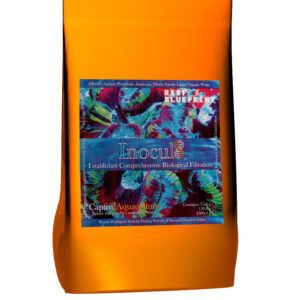Phosphate sol’n; 50,000 ppm. Increases phosphorus, a critical nutrient for survival of photoautotrophs (incl. zooxanthellae), which often becomes biolimiting (slowing or halting primary productivity and cohort growth) in recirculating systems densely-populated with zooxanthellate cnidarians and bivalves, and/or which employ turf scrubber filtration. P deficiency is associated with bleaching. 1 drop (0.05 mL) per 26.4 gal. (100 L) increases phosphate by 0.025 ppm. 50,000 ppm phosphate, derived from potassium phosphate USP.
Parameter
Phosphate
Value
50,000 ppm
Characteristics
-
Active Components: Potassium phosphate, anhydrous, USP
Basic Application
- 1 drop (0.05 mL) per 25.4 gallons (100 L) increases [PO4] by 0.025 ppm.
- 1 mL per 25.4 gallons (100 L) increases [PO4] by 0.50 ppm.
- 5 mL per 20.0 gallons (75.7 L) increases [PO4] by 3.3 ppm.
- Recommended [PO4]: 0.02 – 0.05 ppm.
Discussion
Phosphorus is a critical nutrient for survival of photoautotrophs, including zooxanthellae. In recirculating systems densely-populated with zooxanthellate cnidarians and bivalves, and/or in which algae are utilized as a means of natural nutrient reduction, phosphorus may become a biolimiting nutrient, slowing or halting primary productivity and cohort growth until the concentration is increased; extreme deficiency may result in bleaching.
Application
Keep out of reach of children and unauthorized persons. Avoid contact with skin, eyes, and mucous membranes. Store in a cool, dry location away from sunlight.
The following discussion and recommendations are made expressly for recirculating systems. Laboratory application may proceed as required by study objectives.
The rate of ion depletion due to cohort uptake is driven by various chemical and physical factors which are unique to each independently-operating recirculating system, and which are constantly changing as cohort biomass increases and decreases.
Monitoring (daily) the system’s concentrations of element(s) provided by this formulation and referencing apparent changes in cohort biomass will enable User to adjust dosing of this formula to suit system requirements, improving overall effectiveness and resulting in less wasted solution.
Recommended is diluting an appropriate volume of this solution into a larger volume of purified water (with a purity of at least 98%), and applying this diluted solution to the system with an automated dosing system. Dosing frequency is directly proportional to stability of ionic concentrations and, resultantly, continuous cohort biomass growth. A 1 – 10 s drip interval provides adequate ionic stability, and is recommended.
If no automated dosing system is available, then apply solution manually each day. Dosing frequency is directly proportional to stability of ionic concentrations and, resultantly, continuous cohort biomass growth. Dosage volume per 24 h is divided by the dosing frequency*.
It is not recommended that this formulation be dosed fewer than four times weekly.
Reference Standards: 1 mL Phosph8 diluted in 26.4 gal. (100 L) water yields 0.50 ppm increase of [PO4].
To calculate required solution volume for known parameter differential:
- Multiply net water volume (L) by actual [PO4] (ppm).
- Multiply net water volume (L) by desired [PO4] (ppm).
- Subtract product of Step 1 from product of Step 2.
- Divide difference of Step 3 by 50. Answer is mL sol’n required to achieve desired [PO4] in situ.
Recommended: Do not increase parameter concentration by more than 5% per 24h period in systems with existing cohorts. Aside from emergencies (e.g. excessive nutrient content in an active system, greatly depressed or excessive salinity, etc.), gradual changes in water composition are generally tolerated better by aquatic organisms than are rapid changes.
*Example: If dosage volume per 24 h = 10 mL and dosing frequency = 4, then dose 2.5 mL per event.






